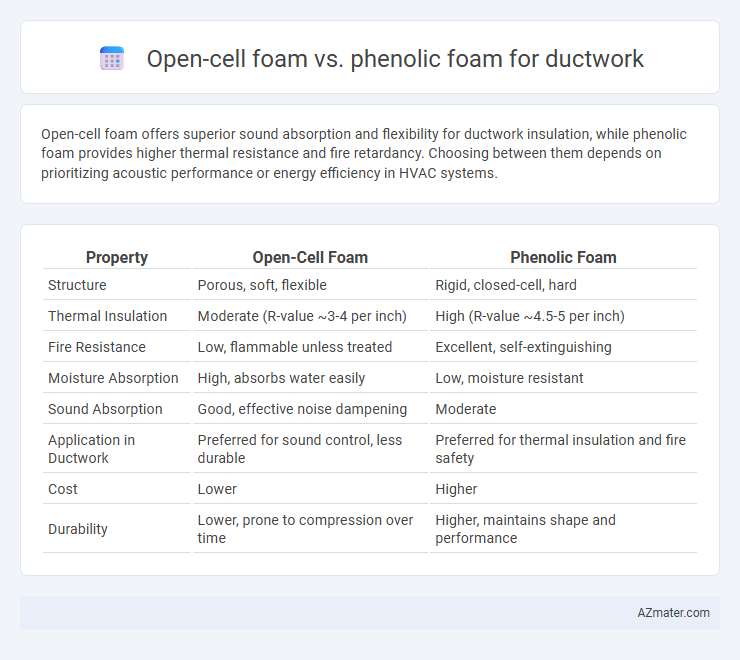Open-cell foam offers superior sound absorption and flexibility for ductwork insulation, while phenolic foam provides higher thermal resistance and fire retardancy. Choosing between them depends on prioritizing acoustic performance or energy efficiency in HVAC systems.
Table of Comparison
| Property | Open-Cell Foam | Phenolic Foam |
|---|---|---|
| Structure | Porous, soft, flexible | Rigid, closed-cell, hard |
| Thermal Insulation | Moderate (R-value ~3-4 per inch) | High (R-value ~4.5-5 per inch) |
| Fire Resistance | Low, flammable unless treated | Excellent, self-extinguishing |
| Moisture Absorption | High, absorbs water easily | Low, moisture resistant |
| Sound Absorption | Good, effective noise dampening | Moderate |
| Application in Ductwork | Preferred for sound control, less durable | Preferred for thermal insulation and fire safety |
| Cost | Lower | Higher |
| Durability | Lower, prone to compression over time | Higher, maintains shape and performance |
Introduction to Ductwork Insulation Materials
Open-cell foam offers excellent sound absorption and thermal insulation, making it ideal for reducing noise levels in HVAC ductwork while maintaining energy efficiency. Phenolic foam provides superior fire resistance and high thermal performance, often used in environments demanding stringent fire safety standards. Both materials enhance ductwork insulation but vary significantly in their thermal conductivity and fire retardant properties.
What is Open-Cell Foam?
Open-cell foam is a lightweight, porous material characterized by interconnected air cells that provide excellent sound absorption and thermal insulation. This type of foam is commonly used in ductwork to reduce noise transmission and improve airflow efficiency. Phenolic foam, in contrast, offers superior fire resistance and dimensional stability, but open-cell foam remains favored for its breathability and cost-effectiveness in HVAC applications.
What is Phenolic Foam?
Phenolic foam is a high-performance insulation material composed of phenol-formaldehyde resin, known for its exceptional fire resistance and thermal insulation properties in ductwork applications. Unlike open-cell foam, phenolic foam offers superior dimensional stability, low smoke emission, and excellent acoustic dampening, making it ideal for HVAC systems requiring stringent fire safety standards. Its closed-cell structure also provides enhanced moisture resistance and durability, ensuring long-lasting efficiency in commercial and industrial duct insulation.
Key Properties of Open-Cell Foam
Open-cell foam for ductwork offers superior sound absorption and excellent thermal insulation due to its porous structure, which allows air to flow through while trapping sound waves. Its lightweight composition enhances ease of installation and reduces structural load, making it ideal for large-scale HVAC systems. The foam's moisture resistance and fire retardant properties ensure durability and safety in duct applications, outperforming phenolic foam in flexibility and noise control.
Key Properties of Phenolic Foam
Phenolic foam for ductwork offers superior fire resistance due to its self-extinguishing properties and low smoke emission, making it ideal for HVAC systems requiring stringent safety standards. This foam features excellent thermal insulation with low thermal conductivity, improving energy efficiency and temperature control within ducts. Its rigid, closed-cell structure provides high compressive strength and moisture resistance, ensuring durability and long-term performance in varying environmental conditions.
Thermal Performance Comparison
Open-cell foam provides superior thermal insulation for ductwork due to its low density and high R-value per inch, effectively reducing heat transfer and energy loss. Phenolic foam offers excellent thermal performance with higher fire resistance and dimensional stability but typically has a slightly lower R-value compared to open-cell foam. Selecting between these materials depends on prioritizing maximum insulation efficiency or enhanced fire safety and structural integrity in HVAC duct applications.
Fire Resistance and Safety Aspects
Open-cell foam offers moderate fire resistance but tends to burn quickly and produce smoke, making it less suitable for ductwork in fire-sensitive environments. Phenolic foam provides superior fire resistance due to its inherent char-forming properties and low smoke emission, enhancing safety in HVAC systems. Regulatory compliance often favors phenolic foam for duct insulation where fire codes demand stringent flame spread and smoke density ratings.
Moisture Resistance and Durability
Phenolic foam offers superior moisture resistance compared to open-cell foam, making it highly effective in preventing mold growth and maintaining insulation integrity within ductwork. Open-cell foam's porous structure allows water absorption, leading to reduced durability and potential corrosion of metal ducts. Phenolic foam's closed-cell composition ensures long-lasting performance by resisting water intrusion and maintaining stable thermal properties in humid environments.
Installation Requirements and Challenges
Open-cell foam offers superior flexibility and ease of installation for ductwork due to its lightweight structure and ability to conform to irregular shapes, reducing the need for extensive customization. Phenolic foam, while providing excellent fire resistance and thermal insulation, demands careful handling because of its brittle nature and requires precise cutting and fastening techniques to avoid damage during installation. The challenges with phenolic foam include its limited flexibility and stricter adherence to protective measures against moisture, which prolongs installation time compared to the more forgiving open-cell foam.
Cost Analysis and Long-Term Value
Open-cell foam offers lower upfront costs for ductwork insulation but may require more frequent replacement due to lower durability compared to phenolic foam. Phenolic foam, while having a higher initial investment, provides superior thermal resistance and fire-retardant properties, resulting in reduced energy expenses and maintenance over time. Long-term value favors phenolic foam because its durability and efficiency lead to significant cost savings throughout the lifespan of the duct system.

Infographic: Open-cell foam vs Phenolic foam for Ductwork
 azmater.com
azmater.com